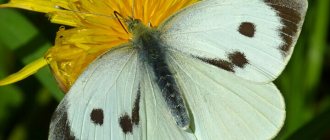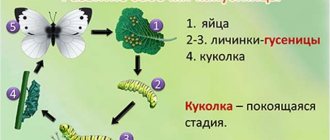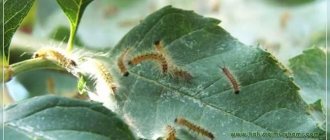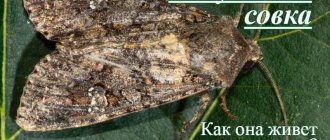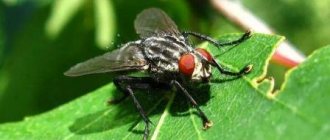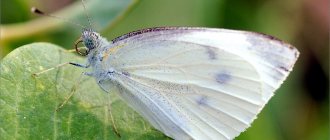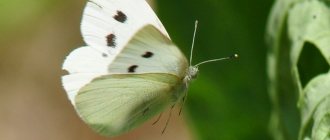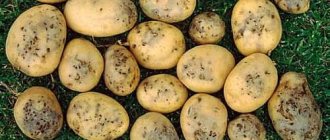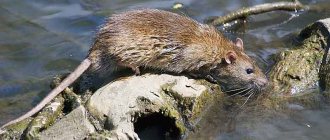The cabbage butterfly is a diurnal representative of the order Lepidoptera of the class of insects. Its other name, white butterfly, symbolizes its color: white wings with small black dots in the center. Whitefish can be seen already in the spring in April or May, fluttering over the first green plants.
Interesting!
Some lovers of lepidopteran insects breed butterflies in their home aquariums. How long cabbage butterflies live in an artificial environment depends on care. They eat the same plants at home as in nature.
But the cabbage butterfly did not gain fame due to its early appearance. It is a dangerous pest of gardens and vegetable plantations. Its larvae are capable of damaging most vegetable crops over the course of a season, although this is not the only thing the caterpillars feed on. Cabbage beds are especially affected by caterpillar infestations. This explains why the insect was named so.
What cabbage whites look like (photo)
Name: Cabbage or cabbage white Lat.:
Pieris brassicaeClass: Insects - Insecta Order: Lepidoptera - Lepidoptera
| Habitats: | a common species, except in Siberia and the desert |
| Peculiarities: | actively migrates, 2-3 generations per season |
| Benefit or harm: | active agricultural pest |
Habitat
Whitefish is widely represented in Eastern Europe and North Africa. Present in Asia and eastern Japan, where the climate is temperate. In the 90s of the last century it was spotted in Southern Primorye. It is found even north of the Arctic Circle. It is clearly established that these are migratory individuals.
In Chile, South America and Panama it appeared solely due to globalization, that is, it was introduced. But still, the butterfly is more often found in the north, where it is not so hot.
The cabbage butterfly prefers meadows and forest edges, park areas and gardens. It takes root well in forest belts and where people live, but subject to the presence of cruciferous vegetables.
Description of the insect
The cabbage white is a small butterfly. The width of its open wings is 5.5-6 cm. The main color of the wings is powdery white. In their upper part there is a black border in the shape of a crescent.
Females also have two black spots on their upper wings. In males, these spots can only be seen on the underside of the wings.
Development cycle
Cabbage whites.
Before becoming an adult, an insect goes through several stages.
Egg
The eggs have a ribbed surface and a bottle-shaped shape. They are painted in a bright yellow, lemon color. The length of the egg is 1.25 mm. One female is capable of laying about 200-300 eggs. The period of development in the egg stage ranges from 3 to 16 days.
Caterpillar
In the caterpillar stage, the insect reaches a length of up to 5 cm. The color of the caterpillar is yellow-green. The body is covered with multiple hairs, bristles and warts. The caterpillar's head is clearly defined and dark in color. The larvae also have glands on their bodies that secrete a toxic substance. The insect remains in the caterpillar stage for 13 to 38 days.
Doll
The pupae have an angular shape and are colored yellow-green. There are black dots on the sides and back. The development of the pupa can take from 9 to 30 days. Pupae can overwinter in the ground on mats of mulberries.
Nutrition of larvae and adults
The second and third generations of insects become a real disaster for summer residents and gardeners. The first month of summer is the most favorable for breeding offspring of the cabbage butterfly. The insect’s favorite food crops appear in the garden:
- cabbage;
- radish;
- turnip;
- horseradish;
- turnip;
- radish;
- garlic;
- capers.
The pest most often leaves egg masses on the underside of the leaves of these vegetable crops. The emerging caterpillars begin to actively feed on juicy young leaves. First they eat the outer side, then move to the central part. By damaging the leaves of vegetable crops, the caterpillars disrupt the processes of photosynthesis in the plant, thereby causing irreparable damage to the future harvest.
On a note!
When the larvae eat the cabbage leaves down to the base, they move on to the inner leaves of the cabbage head. This leads to the destruction of the entire plant.
An adult white moth does not damage vegetation. Cabbage butterflies eat nectar and pollen of wildflowers:
- dandelion;
- chamomile;
- alfalfa;
- coltsfoot;
- meadow greenweed.
Cabbage butterfly
The life span of an adult butterfly depends on weather conditions. Warm, dry, windless days with an average temperature of 20-25 degrees Celsius are optimal for it. This explains why many cabbage butterflies can be seen on vegetable plantations in the southern regions.
Interesting!
Cabbage girls are by no means such homebodies as they are considered. Entomologists have repeatedly observed mass migrations of butterflies. It has been noticed that from the southern regions they fly north in the summer. They move along a clearly defined route and even obstacles will not force them to deviate from their chosen direction. In calm weather, the speed of cabbage varies in the range of 7-14 km per hour. In the presence of wind, butterflies can travel up to 36 km per hour.
Methods to combat cabbage whites
Getting rid of harmful insects is quite difficult.
The most effective methods of controlling cabbage whites can be divided into mechanical, agrotechnical, biological, chemical and folk.
Mechanical method
This method involves removing caterpillars from plants by hand. It is simple to implement, but quite labor-intensive, so it is suitable only for small plots and private gardens. Most of the larvae will have to be lifted from the ground, since, sensing danger, they curl up and fall from the plants.
Cabbage caterpillar.
Agrotechnical method
In order not to attract insects to the site, it is very important to regularly get rid of cruciferous weeds and plant plants that can repel the pest. These include:
- tomato;
- eggplant;
- carrot;
- parsley;
- Melissa;
- valerian.
Removing plant debris and deep digging in the autumn will also help get rid of overwintering pupae and significantly reduce the butterfly population in the spring.
Biological method
The principle of the biological control method is to settle its natural enemies next to the cabbage plant.
| Smallbellied | A small insect that lays eggs in the body of a caterpillar. The parasites that hatch from these eggs eat their host from the inside. |
| Trichogramma | The parasite also harms the eggs and larvae of Cabbage White. |
| Wax moth bacteria | They infect the larva with the Flasheria disease, which leads to the death of the pest. A distinctive feature of an infected caterpillar from a healthy one is its bright lemon color. |
| Ethnomophages | These are beneficial insects that benefit humans by eating pests. Cabbage white is a favorite delicacy of ticks and predatory ground beetles. |
Chemicals
The use of specialized drugs is the most effective method of control. To destroy Cabbage White, the most popular means are:
- Kinmiks;
- Fitoverm;
- Aktellik;
- Lepidocide;
- Bitoxibacillin;
- Entobacterin;
- Gomelin;
- Dipel.
Folk remedies
Humanity has been fighting cabbage whites for many years, and some folk methods of control are quite effective. Among them it is worth highlighting:
- solution with valerian tincture. For preparation, use 500 ml of valerian tincture per 3 liters of water. The prepared mixture must be thoroughly sprayed on all affected plants;
- dry mustard and wormwood. During the flowering period of wormwood, it is necessary to collect and dry about 1000 g of its inflorescences. After the wormwood has dried, you need to add 100 g of dry mustard and 10 liters of boiling water. The product should be infused for 2-3 days. The finished tincture is diluted with cold water in a 1:1 ratio and used for processing. Spraying must be carried out at least once a week;
- field chamomile flowers and laundry soap . Dried wild chamomile flowers are sold in pharmacies. To prepare the tincture you will need 1 kg of flowers and 10 liters of water. They are infused for 12-24 hours, then filtered and 100 g of laundry soap are added. Another 10 liters of water are added to the finished tincture and used to spray the affected plants.
Doll
What does a cabbage butterfly look like in the pupal stage? The color is almost the same as that of the butterfly - yellowish-green with black splashes.
When transitioning to the pupal stage, the larva is wrapped in threads somewhat reminiscent of silk, and with them it clings to plants.
If the folding into a chrysalis did not occur too late, then a butterfly will soon be born. If the atmospheric temperature does not allow the transformation to occur, then the insect enters the diapause stage and overwinters. With the onset of spring, such insects begin their first generation.
For information, diapause is the process of inhibition of physiological processes in an insect with a transition to the stage of suspended animation.
The insect remains in this stage for several weeks. During this period, the pupa molts several times, and this process is called complete metamorphosis.
Prevention measures
Prevention of the appearance of Cabbage White is the timely destruction of pupae and oviposition. To prevent the spread of the pest, you must do the following:
- periodically inspect the underside of the leaves of cruciferous plants and destroy the eggs found;
- inspect dry branches, tree trunks, barn walls and other places where pupae may overwinter;
- Regularly carry out spring whitewashing of tree trunks and main branches.
Structure
The cabbage butterfly has a hairy body, very similar to that of the cockchafer. Consists of three departments:
- abdomen;
- head;
- chest with fused segments.
The butterfly has three pairs of legs, at the end of each of which there are very sharp claws that allow it to stay on trees and plants.
Like other butterflies, the cabbage butterfly has only a developed pair of lower chitinous jaws, which can chew even a cabbage leaf.
How to detect a pest and what is its danger
It should be noted that the adult cabbage plant is harmless and does not pose a threat to garden crops. The situation is different with its larvae. Most often, the butterfly lays eggs on cabbage, but the voracious larvae can also feast on horseradish, radish, turnips, etc.
Caterpillars methodically eat cabbage leaves or other plants. They feed mainly at night, and during the day they accumulate at the base of the head of cabbage. A large number of larvae can completely destroy a cabbage crop.
It is not difficult to detect malicious larvae. It is enough to inspect the lower parts of cabbage or other plants. The accumulation of cabbage eggs on the leaves threatens the further growth and development of the plant.
What harm does it cause to a person?
White butterfly caterpillars are well camouflaged as cabbage leaves due to their greenish color. In addition to cabbage, they can be traced in the garden on raspberries. There is no need to worry in such cases - caterpillars cannot eat hard raspberry leaves. However, fruit and berry plants located near raspberries are at great risk. A hungry caterpillar can eat leaves from the very edges to the veins.
